By Manuel “Bobby” M. Orig, Director, ApoAgua
Collected from NUTS! Southwest Airlines Crazy Recipe for Business and Personal Success by Kevin Freiberg and Jackie Freiberg
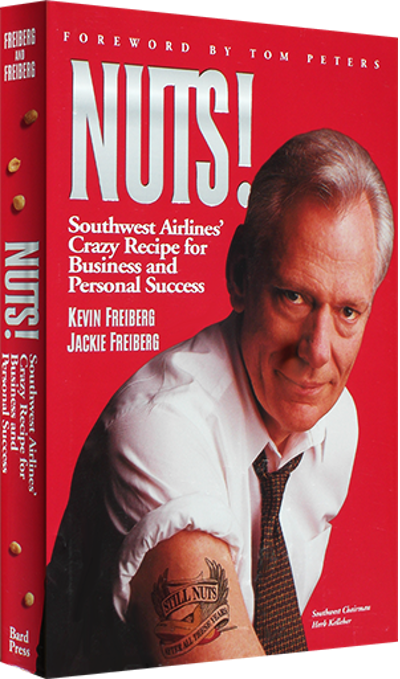
I compiled this compendium of events, facts, figures, strategies, and stories from the book Nuts, by Kevin and Jackie Frieberg, to give you rich insights into how Southwest Airlines’ legendary founder, Herb Kelleher, created the greatest success story in the history of commercial aviation using approaches that, in most cases, defy convention. (Yes, that’s Kelleher sporting a nuts tattoo on the book cover.)
It will give you as well interesting insights into how Southwest Airlines has consistently turned a profit for twenty-four consecutive years and seen its stocks soar 300% since 1990. And why this company is enjoying a continuing love affair with its employees and customers.
In short, it shows why everybody is nuts about Southwest Airlines!
Foreword by Tom Peters
Co-author of In Search for Excellence
Southwest is “Air Travel’s Greatest Show on Earth” because of its on-time service, baggage handling, and no assigned seats. While most organization’s are boring and rigid, Southwest is just the opposite.
What I discovered is an organization that dares to unleash the imagination and energy of its people. They make work fun – employees have the freedom to act like NUTS. There is a spirit of entrepreneurship – much more than a decentralized organization chart – an attitude that extends to every corner of the company.
If you don’t already know it, Southwest reinvented air travel twenty-six years ago with its low fares and zany, irreverent style. These NUTS made flying an event.
Today, Southwest keeps air fares rock bottom by keeping costs low, satisfies customers by getting people and baggage to their destinations on time, practices the Golden Rule at work and in the communities it serves, and the best productivity and safety records in the industry.
How has Southwest done all this? It’s not rocket science – keep costs low, productivity high, service positively outrageous, and black ink on the financial statement.
These three special things I see:
- Being crazy enough to follow an unorthodox vision,
- Being outrageous enough to allow people to have fun and be “real” people who love and care at work,
- Being smart enough to recognize that their most valuable assets are their people and the culture they create.
Southwest never forgets it is in the people business – the company just happens to operate an airline.
Praise from Gary E. Hoover
Founder of TravelFest, BOOKSTOP, and Hoover’s, Inc., publisher of Hoover’s Company Profiles
The Southwest Airlines story, told in colorful detail at last, is undoubtedly one of the most important lessons in corporate America today. Do one thing, do it well, do it over and over and over again, and be true to your spirit – and you can beat the established industry giants. There is no better example of the importance of a simple, clear, and consistent vision in business success.
About the authors

Kevin and Jackie Freiberg are bestselling authors and founders of the San Diego Consulting Group Inc. The Freibergs are dedicated to helping leaders create the Best Place where the Best People can do their Best Work to make the world better. Both have Ph.D.’s and teach part-time at the University of San Diego, School of Leadership and Education Sciences.
The Freibergs speak on leadership, innovation and change all over the world. They have global practice including firms in Europe, Japan, South Africa, Central and South America, as well as companies throughout the United States and Canada.
From twenty three chapters of the book, Nuts, by Kevin and Jackie Freiberg, here is a compendium of events, facts, figures, strategies and stories which led to Southwest Airlines being considered an eccentric company yet rated as one of the most admired airline companies in the world.
- Since 1971, this eccentric and outlandish company has established a consistent pattern of deviating from convention. When other airlines were creating hubs, Southwest was flying point to point. Instead of serving expensive meals, flight attendants pass out nuts. Instead of wearing stuffy uniforms, they wear sport polo shirts and shorts.
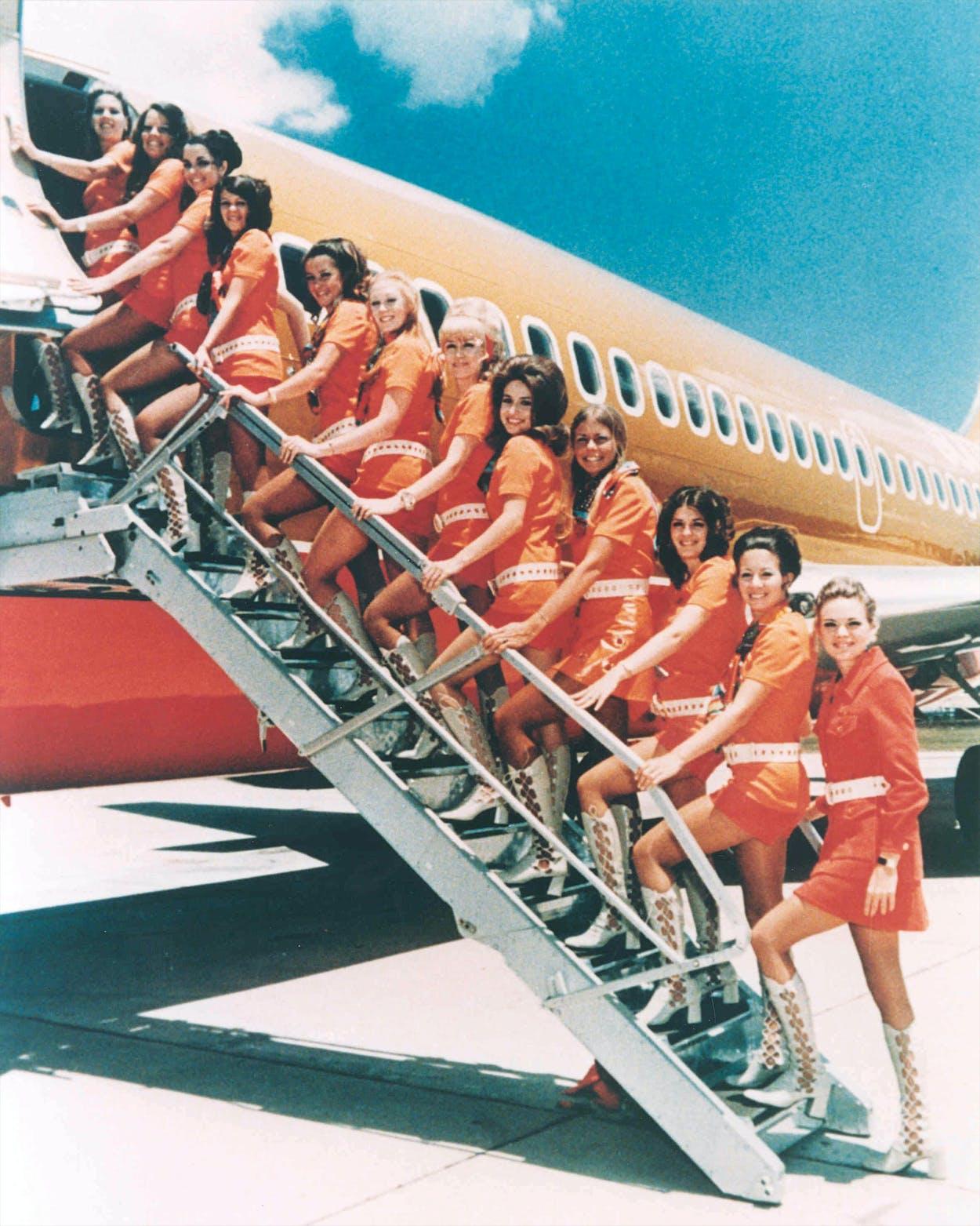
- In an industry that is still reeling from the $12.8 billion loss it posted between 1990 and 1994, Southwest was the only airline to be profitable each year during that period. During this time the airline industry lost more money than it made in the previous sixty years. Southwest Airlines is the only U.S. airline to earn a profit every year since 1973. It’s profit margins -averaging over 5 percent since 1991 – have been the biggest in the industry.
- Before Southwest capitalized on the idea of offering permanent low fares, the U.S. airline industry as a whole charged uniformly high fares approved by the Civil Aeronautics Board. The airlines operated as though there were only two market segments: those who could afford to fly and those who could not. This assumption guided the operating strategy of the major carriers. When problems arose or costs went up, they would simply raise fares. Southwest, however, believing that it could stimulate a tremendous amount of new travel with low fares and superior service, challenged this assumption from day one.
- Southwest perfected system-wide two-tier-peak and off-peak – airline pricing that eventually reshaped the industry. It occurred to them that there are really two types of travelers that an airline had to satisfy if it were to cover the entire market spectrum: the convenience-oriented business traveler, who has more time – than price sensitive and the price-sensitive leisure traveler, who primarily wanted low fares and had more flexibility about when to fly.
They devised the Executive and Pleasure Class system-wide two-tier price structure, in which all seats on Executive Class flights, departing on weekdays until 7 P.M. were sold for $26 (a 30 percent increase over Southwest’s original $20 fare), and all seats on Pleasure Class flights, departing after 7 P.M. on weekdays all day Saturday and Sunday, were sold for $13 (a 35 percent reduction from Southwest’s original $20 fare). Passenger traffic skyrocketed!
Southwest, through improvisation, had given birth to what would become one of the most widely emulated marketing innovations in airline history – systemwide peak and off-peak pricing.
- Southwest’s outrageous personality partially resulted from desperation. During the first year of operation, when half of Southwest’s $700,000 advertising budget was spent in the first month, word of mouth became the best and only affordable form of advertising. Says then secretary Sherry Phelps: “For the talk value, we decided that we needed to make our company absolutely outrageous.”
The company realized early on that the more outrageous it was, the more people talked. With the help of its advertising agency, the company set out to define the airline as a woman – a witty, pert, with-it, startling woman. It was the first airline to dress flight attendants in hot pants. Southwest projected that “person” into a “hard-hitting and spectacular campaign,” says Kelleher. It was the “love” campaign that successfully defined the airline and gained critically needed publicity.
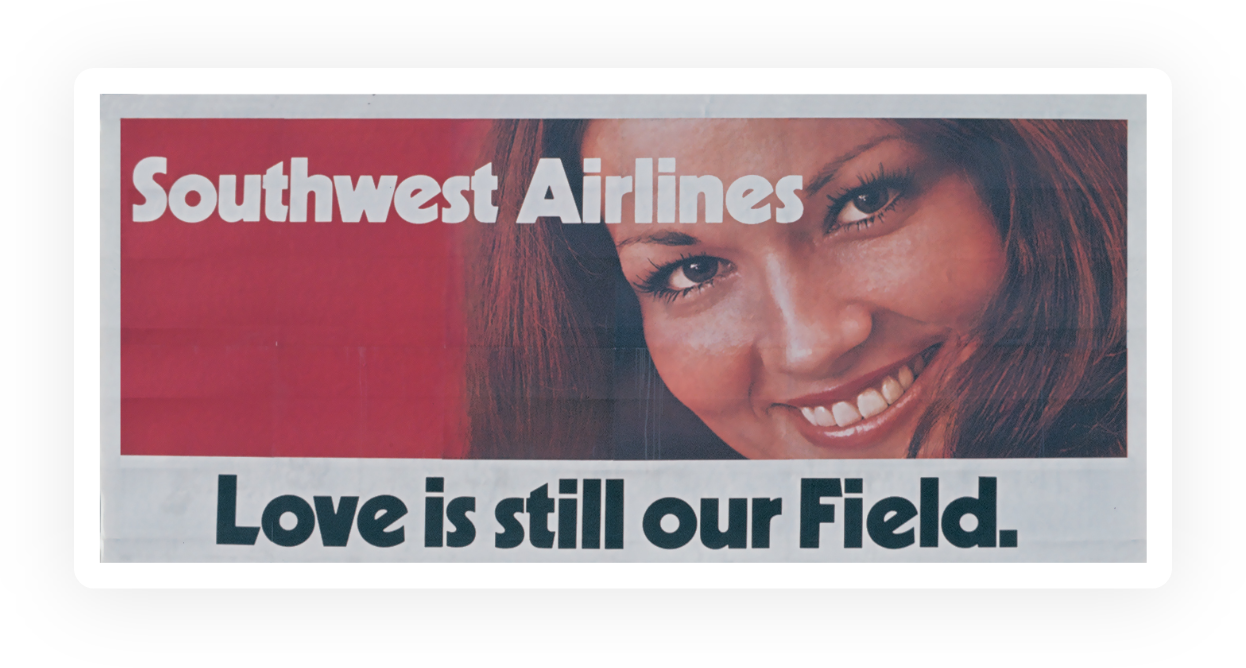
- Southwest Airlines’ recipe for success is really no secret at all. In fact, the ingredient that has catapulted Southwest to the top of the industry is simple, elegant, and well publicized: discipline. Throughout its existence, Southwest has consistently adhered to a clearly defined purpose and a well-thought-out strategy for accomplishing it. As simple as it sounds, Southwest exists to make a profit, achieve job security for every employee, and make flying affordable for more people.
- In serving its specific market niche, Southwest is obsessed with keeping costs low to maximize profitability instead of being concerned with market share. Kelleher believes that confusing the two concepts has derailed many firms that were otherwise on track in fulfilling their fundamental purpose. “Market share has nothing to do with profitability,” he says. “Market share says we just want to be big; we don’t care if we make money doing it. That’s what misled much of the airline industry for fifteen years, after deregulation. In order to get an additional 5 percent of the market, some companies increased their cost by 25 percent. That’s really incongruous if profitability is your purpose.”
- Southwest is anything but traditional. Its unconventional and nonconformist approach has helped the airline simplify its business and stay focused on adding value to the service it gives its customers.
Southwest has never subscribed to the computer reservations systems, in the same way as other major travel airlines. Travel agents wanting to book customers on Southwest flight have to pick up the phone and call its internal reservation offices instead of having direct access through a computer. Not subscribing to a computer reservations system saves Southwest millions of dollars a year.
Southwest serves no meals. With flights averaging approximately sixty minutes, there is little time for meal service. Instead Southwest serves peanuts.
And how does the customer respond to this simplicity? If passenger boardings are any indication, people are willing to trade some of the amenities for low fares, better baggage handling, and Southwest’s unique brand of Positively Outrageous Service.
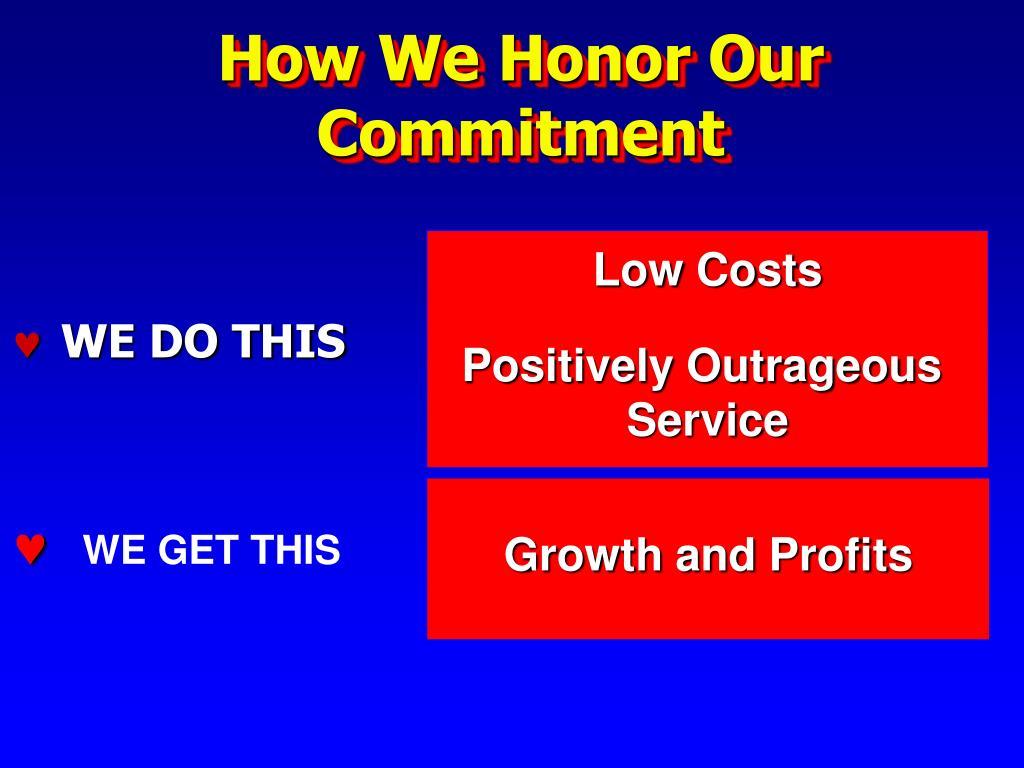
- Southwest has always resisted the temptation to be something it’s not. Perhaps this is because the people of Southwest Airlines know that arrogance is the quicksand of success. Kelleher began his 1993 letter to all employees by outlining the major threat to Southwest Airlines in the ‘90s. “The number one threat is us. We must not let success breed complacency; cockiness; greediness; indifference; preoccupation with nonessentials;…or obliviousness to threats posed by the outside world.”
In exercising discipline driven by humility, Southwest has never been known for getting too caught up in its own accomplishments or taking itself too seriously. It has remained fixated on purpose and strategic intent. Southwest had more opportunities for growth than it has airplanes. Yet, unlike other airlines, it has avoided the trap of growing beyond its means.
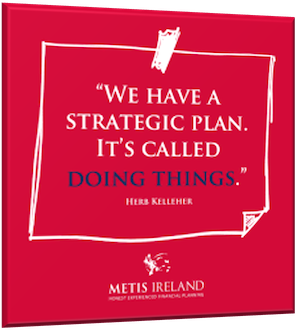
- At Southwest, “professional” and “businesslike” alone just won’t cut it. In fact, these are terms Kelleher despises; he believes they have lost their meaning. “Anybody who likes to be called professional shouldn’t be around Southwest Airlines,” he says. “We want people who can do things well with laughter and grace.”
The point here is not to offend people who think of themselves as professionals. Southwest is bursting with professionalism, but it is a unique brand, practiced with flair. The type of professionalism people experience within the Southwest culture is not the stuffy, serious professionalism guarded by the philosophy that “the business of business is business.” Instead, the professionals that customers encounter at Southwest are remarkably uninhibited and empathetic individuals who believe that the business of business is to make a profit by serving people and making life more fun.
- According to Southwest’s corporate philosophy, bureaucracy exhausts the entrepreneurial spirit, slows the organization down, and constrains its competitive position. That is, bureaucracy creates a mindset of dependency, which makes people do what they are told but no more. Rather than encouraging employees to assume ownership and responsibility, bureaucracy teaches them to transfer responsibility.
Leanness, on the other hand, gives control, ownership, and responsibility to those who are closest to the action. Southwest allows its people a lot of decision-making power and authority. With no more than four layers of management between a front-line supervisor and Herb Kelleher, the leader’s span of control is very broad at Southwest.
- As any company grows, structure becomes necessary. Yes, there is a hierarchy at Southwest, but the company operates so informally that people are free to go around, over, and under the formal structures whenever they need to.
Kelleher says: “We’ve tried to create an environment where people are able to, in effect, bypass even the fairly lean structures that we have so they don’t have to convene a meeting of the sages in order to get things done. In many cases, they can just go ahead and do it on their own. They can take individual responsibility for it and know that they will not be crucified if it doesn’t work out. Our leanness requires people to be comfortable in making their own decisions and undertaking their own efforts.”
- When Desert Storm (Gulf War waged by a coalition of 35 nations against Iraq), jet fuel prices skyrocketed. Kelleher proudly remembers how quickly the pilots responded to the crisis this created: “I wrote a memo to our pilots and said, ‘Fuel is just going sky high, we’ve got to cut back.’ And in one week our costs went down, just like that. Now, let me contrast that with the consultant who wanted to set up an incentive program, whereby pilots’ pay would be increased to the extent they conserved fuel. I kept telling the guy we didn’t need to do that. Our pilots just did it on their own.”
This incident perfectly illustrates the entrepreneurial spirit and ownership mentality Southwest employees bring to the job and the power of their initiative when they know how closely aligned their interests are with those of the company. The real secret to Southwest’s success is having one of the most highly motivated and productive work forces in the world. They are motivated by a sense of fairness that says, “We want your well-being to be tied to the company’s well-being because, after all, you are the company.”
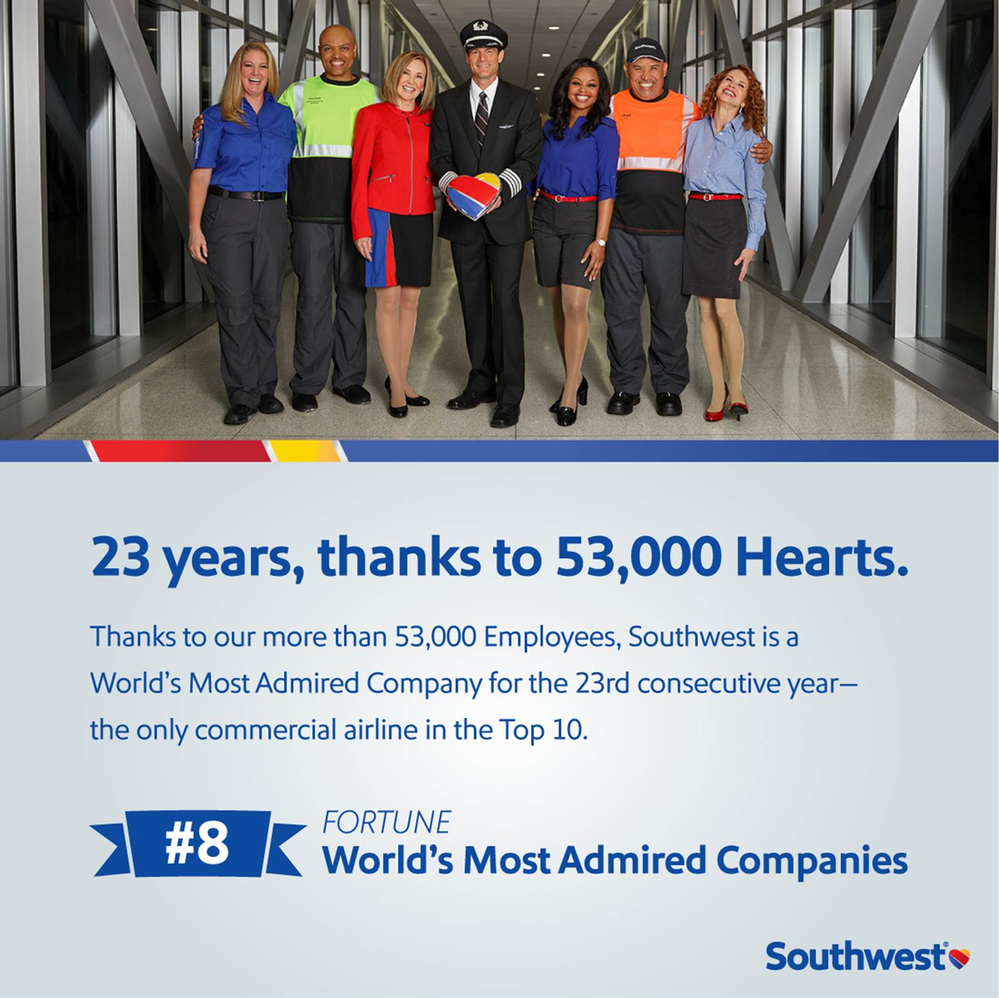
- Southwest’s University for People is a multi-tiered learning facility staffed by the Employee Learning and Development Department. Its primary mission is to equip employees to practice the kind of leadership that Southwest Airlines expect.
Faculty serves as internal consultants and change agents to ongoing work groups within the company. Because Southwest knows its growth depends upon the growth of its people, the University offers a full catalog of courses designed to teach people how to lead with integrity, run a profitable airline, practice the principles of stewardship, care for customers, and live the company’s core values. The University reinforces the importance of learning as a way of life at Southwest Airlines.
- Southwest disseminates massive amounts of information that grabs people’s attention and leads to new understanding. LUV Lines, its corporate newsletter is a powerful and effective tool for creating new knowledge. It is filled with information that employees look forward to. The information is presented in such a way that it causes people to want to learn.
In addition to featured topics, the newsletter includes several sections (e.g. “The Learning Edge,” “How Do We Rate,” “Industry News”) that keep Southwest’s workforce informed on business developments and inspire new ways of thinking about their jobs. By creatively and frequently disseminating information, Southwest is empowering its work force to pioneer innovation and willingly embrace change.
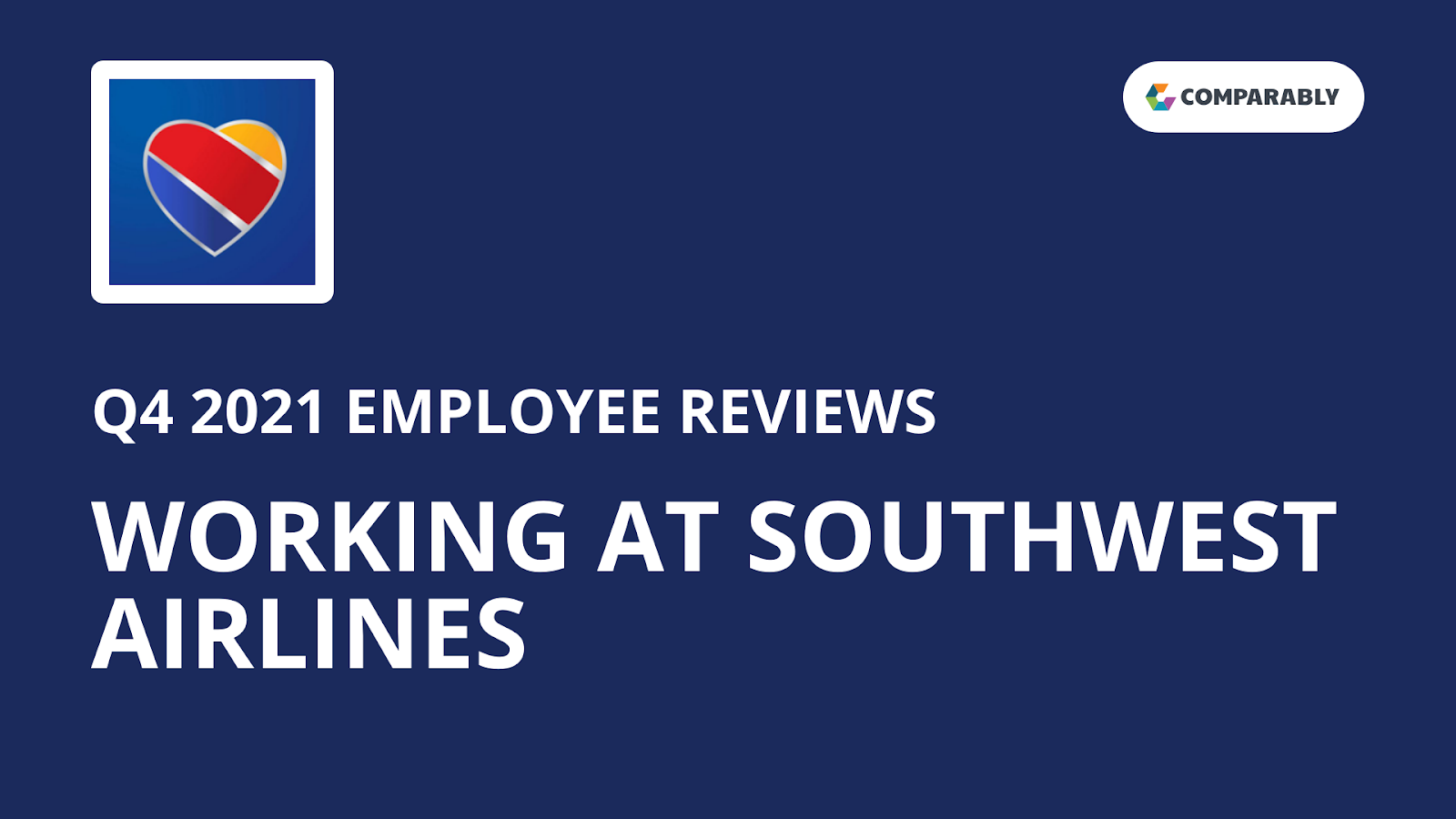
- Continually trying to help employees learn how their individual contributions make a difference is what distinguishes Southwest from a lot of other companies. It is rare for front-line employees to be as well educated and informed as they are at Southwest. Southwest treats front line people like owners and partners who not only have a right to information but more importantly need to know it in order to do their jobs effectively.
As part of its effort to keep employees informed, Southwest communicates the importance of every single customer by educating employees how many customers the company actually needs to make a profit. By demonstrating to employees how just a few people can make the critical difference, the company encourages them to think about how their individual behaviors influence customer service. In November 1995, LUV Lines put customer service in perspective with the following piece on profitability:
How important is every customer to our future? Our Finance Department reports that our break-even Customers per flight in 1994 was 74.5, which means that, on average, only when Customer #75 came on board did a flight become profitable!
Aside from that statistical data, let me share with you a down-to-earth formula devised by our Dallas chief pilot, Ken Gile. It utilizes our annual profit and total flights flown to clearly illustrate how vital each customer is to our profitability and our very existence.
When you divide our 1994 annual profit by total flights flown, you get profit per flight:
$179, 331,000 (annual profit)
__________________________ = $287 (profit per flight)
624,476 (total flights flown)
Then divide profit per flight by Southwest’s system-wide average one-way fare of $58:
$287 (profit per flight)
__________________________ = 5 (one-way fares [customers!]
$58 (average one way fare)
The bottom line, only five Customers per flight accounted for our total 1994 profit! In other words, just five customers per flight – only 3 million of the 40 million Customers we carried – meant the difference between profit and loss for our airline in 1994. To take it a step further, to have lost the business of only one of those customers would have meant a 20 percent reduction in profit on that flight. That’s how valuable each Customer is to Southwest and you.
Every employee at Southwest Airlines understands that the company is in the customer service business. Captain Giles formula helps make customer service tangible and personal for Southwest employees.
- The LUV Lines article did not stop with customer/profit statistics. It went on to educate employees about the importance of recovering from a poor service incident:
Studies reveal that on average, for each Customer who was “wronged,” there are 25 others who remained silent. The studies claim that each person in this silent majority will, by word of mouth, tell between 8 and 16 people – an average of 12 – of their complaint. (Over 10 percent will tell more than 20 people!) When you do the math, a potential of 300 people can be influenced by just one negative situation. Here is what that factor means to Southwest Airlines:
Last year, we heard 60,000 Customers who were dissatisfied with some aspect of their experience with us. (Happily, employee commendations outnumbered complaints by five to one!).
60,000 (“wronged” Southwest Customers)
x 25 (silent majority)
= 1,500,000 possible dissatisfied Southwest Customers
Now if those 1.5 million dissatisfied Customers told 12 others of their experience:
1,500,000
x 12 (word of mouth)
= 18,000,000 potential “influenced” Southwest Customers
Do you think that 18 million is enough Customers to put us out of business? And, when you compare that 18 million potentially lost or never-reached Customers with the 3 million which accounted for our total 1994 profit, the significance of each and every customer becomes even more apparent.
There is, however, a positive aspect of Customer complaints! The aforementioned research also indicates that if you make a sincere effort to remedy complaints and regain Customers’ goodwill, 82 to 95 percent of those Customers will stay with you!
“The company believes that employees who become ‘literate’ through articles like this are better equipped to provide their unique brand of warmth, friendliness, and hospitality to Southwest customers,” says Ginger Hardage, VP of Public Relations and Corporate Communications. What makes it so powerful here is that the writers of LUV Lines take the time to apply these studies in a way that is relevant and educational to Southwest employees.
- Southwest Airlines has chosen to fly in the face of convention and conformity. The company deliberately hires people who are not afraid to express their individuality and color outside the lines. At Southwest there is no socially prescribed role that will gain you acceptance. Certainly, there are values and guidelines: providing Positively Outrageous Service and treating coworkers with kindness are non-negotiable. But the company encourages employees to live these values their own way.
- Several years ago Kelleher came up with what he thought was a great concept for a new flight schedule. He got hot on the idea of reducing Southwest’s flight schedule to shirt-pocket size, making it less cumbersome for the customer. Although the Marketing Department opposed the idea, Kelleher continued to press for it. This went on until, finally, someone in marketing had the courage and insight to create a prototype schedule the size Herb was advocating. When they presented it to him, the print was so small he couldn’t read it. Kelleher remembers saying, “I think I got the message now.”
Southwest employees demonstrate a lot of creativity with regard to cutting costs. But in many situations cost cutting requires someone who is not afraid to challenge the system. One of Southwest’s flight attendants, Rhonda Holley, suggested that the company remove its logo from the white plastic bags used for collecting trash at the end of the flight. Her argument was that nobody really cares about a logo on a trash bag. After Joanne Lardon, the purchasing manager and Joyce Rogge, vice president for advertising and promotions, looked into it, they decided that Holley had a good point. By using trash bags without logos, Southwest now saves $300,000 a year.
Southwest also encourages employees to challenge conventional wisdom. Kelleher is fond of saying, “From the beginning we told our people, ‘Question it. Challenge it.’ Remember decades of conventional wisdom has sometimes led the airline industry into huge losses.”
At Southwest every employee is a steward of the company’s mission. If a policy or a practice appears to violate the intent of the company’s mission or is inconsistent with its values, people are expected to speak up.
- On January 31, 1995, Southwest Airlines became the first major carrier to offer ticketless travel systemwide. This milestone is an example of the creativity and entrepreneurial spirit by Southwest employees when they are in a crunch. Southwest has been ejected from three major reservations systems. Conventional wisdom says that if 55 percent of your business comes through the computer reservations systems and you get kicked off three of them, you’re in big trouble. Unless of course, you decide to sidestep those reservations systems altogether.
In May 1994 employees from Ground Operations, Systems, Reservations, Finance, Technical Services, Customer Relations, Executive Office, Network Operations, Internal Audit, and Marketing got together to figure out how they could do just that. The group met on their own initiative, without seeking permission from anyone to pursue the project. Bill Lyons, controller, led a core team through the rigors of designing a ticketless system. In just four months the new system was ready. Meanwhile, Kelleher sprouted off at an American Society of Travel Agents that Southwest would go ticketless before he even knew that an entrepreneurial group within the company had been working on the idea.
Ticketless travel allows customers to bypass the computer reservations systems completely. The benefits to customers and to Southwest are enormous. Less paperwork to be processed means greater savings. Quicker processing means shorter lines at the ticket counter. Some consultants estimate that an airline’s direct costs for issuing a paper ticket are approximately $7. When you figure that Southwest issues forty million tickets per year, the savings are significant. Southwest anticipates that ultimately, its costs will be reduced by as much as $100 million a year. Customers gain the convenience of ticketless travel and also benefit from the cost savings passed on in continued low fares.
- “There is a growing concern that companies cannot live by numbers alone.” So said Fortune magazine to introduce the results of its 1995 Corporate Responsibility survey. “The one thing that set the top ranking of companies in the survey apart is their robust cultures.”
A company’s culture, like a person’s character, drives reputation. It should come as no surprise that the companies whose cultures honor customers, employees, and shareholders alike have excellent reputations. Fortune ranked Southwest number one in the airline industry for 1994, 1995, and 1996.
The idea of a corporate culture is too important to the effective functioning of today’s organizations to be dismissed as a fleeting craze. Culture is the glue that holds our organization together. It encompasses beliefs, expectations, norms, rituals, communication patterns, symbols, heroes, and reward structures. Culture is not about magic formulas and secret plans; it is a combination of a thousand things. Kelleher believes that culture is one of the most precious things a company has, so you must work harder at it than anything else.
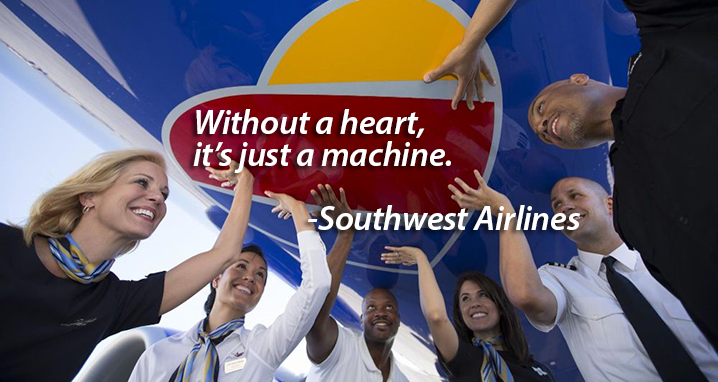
- The legend and the love, the vision and the values, the philosophies and the principles mixed with, in Kelleher’s words, “boundless energy, immense goodwill, and a burning desire to excel” are known in the company as the Spirit of Southwest.
“Spirit is engaging our minds and our hearts and our souls to do the right thing. Southwest spirit is you,” says the Professor, the animated character who narrates Southwest’s Keepin’ the Spirit Alive video.
The Southwest Spirit, says the Professor, “is the twinkle in your eye, the skip in your step; it is letting the childlike spirit escape and be heard. To know what really makes Southwest Spirit, you have to look beyond the machines and things because running a fun and productive airline defies science; it is an art that comes from working hard with feeling.”
- A MESSAGE TO THE FAMILY
Employees and visitors entering Southwest Airlines’ corporate headquarters at Love Field in Dallas, Texas, are greeted with this spectacularly displayed message on a window that stands fifteen feet high and twelve feet wide:
The people at Southwest Airlines are “the creators” of what we have become – and of what we will be.
Our people transformed an idea into a legend. That legend will continue to grow only so long as it is nourished – by our people’s indomitable spirit, boundless energy, immense goodwill, and burning desire to excel.
Our thanks — and our love- to the people of Southwest Airlines for creating a marvelous family and a wondrous airline!
Kelleher himself wrote this message, which was unveiled in front of three thousand employees and guests of employees at the corporate headquarters open house in 1990.
- When individuals join Southwest, they join more than a $3 billion corporation; they join a community. Southwest likes to say, “Welcome to our extended family” – a family of people who are committed, invested, dedicated, and passionate about the cause of Southwest Airlines.
“The cause of Southwest Airlines is to increase the collective prosperity of all of the employee family,” says John Jamotta, director of schedule planning. This fundamental mission has become a covenant that draws employees together in a bond continuously cemented in their minds by vivid reminders of the importance of family and by memorializing the family’s history.
- Southwest is not the only company that has demonstrated the virtue of hard work and the resulting urge to celebrate. However, the difference between Southwest Airlines may be that when the hunger to celebrate is felt, particularly after a stunning victory, rather than ignore it or avoid it, Southwest nourishes it.
After observing the joy and aliveness exhibited by people at Southwest Airlines, the authors concluded that the cost of not responding to the human spirit for celebration is very high. Celebration enhances our humanity. Without celebration, we are robbed of the life and vitality that energizes the human spirit. Latent and undeveloped though it may be, there is within our nature as human beings an inherent need to sing, dance, love, laugh, mourn, tell stories, and celebrate.
To deny our need to celebrate is to deny a part of what it means to be human. When we work at an environment where we are not encouraged to express this festive nature, part of our humanity is repressed and life becomes dull and spiritless. When this happens, our celebrative faculties, like unused muscles, begin to atrophy. This has a devastating impact on morale and productivity.
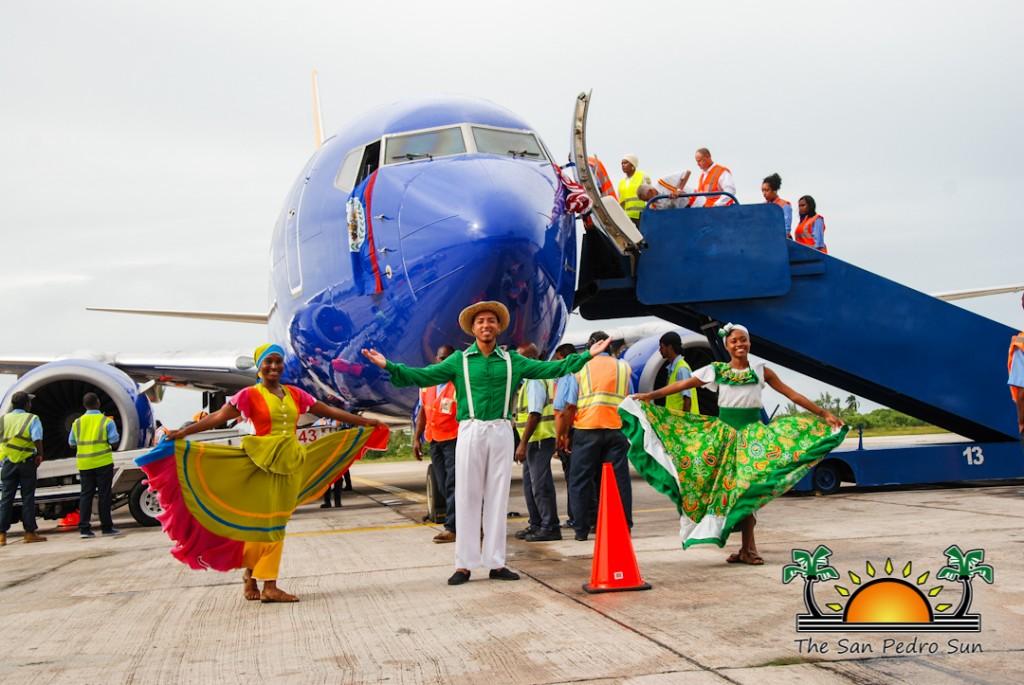
- If you look at Southwest’s stock price on the New York Stock Exchange, you’ll find it under the ticker symbol LUV. The ticker symbol not only represents an advertising theme since 1971, it also exemplifies the loving character of the company. Southwest has become a loving place to work because of the kind of people who work there. “We are interested in people who externalize, who focus on other people, who are really motivated to help other people,” Kelleher once said.
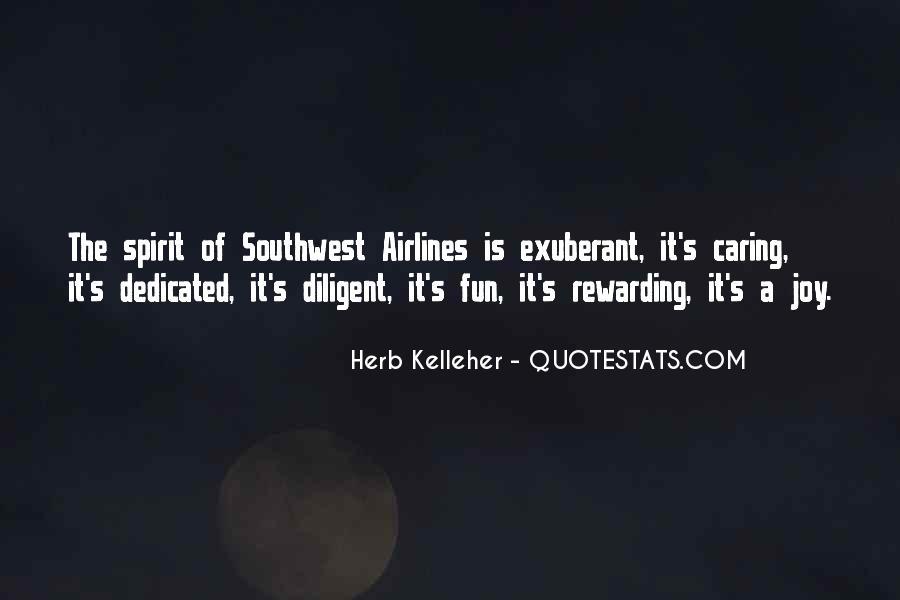
- If you are careful about hiring loving people, it should come as no surprise that acts of love and generosity will naturally spill out of them. It should also come as no surprise that when you get enough people with these attributes in the same company, a corporate character is created that practices love as a way of doing business.
When it comes right down to it, the deepest need in our human existence is the need to be loved and accepted. Southwest Airlines understands that this need doesn’t change suddenly or mysteriously disappear when employees walk through the door at work.
“The greatest disease in the world today is not TB or leprosy; it is being unwanted, unloved, and uncared for,” says Mother Teresa. The disease of which Mother Teresa speaks about is not relegated to the street; it can also be found inside the corridors of corporate America. An antidote to loneliness, despair, and hopelessness is found in the lessons we’ve learned about love at Southwest Airlines and how it is expressed there.
- Many companies think that if they purchase enough TV time, print space, or radio spots, consumers will eventually break down and buy simply because they are overwhelmed.
Southwest has a different approach. It uses communication in a much broader sense. Southwest’s communication – its message – is its people. Every person in the company is a message. Southwest has twenty-five thousand employees spreading the word as missionaries who are not afraid to be a little offbeat, work hard, and have a lot of fun. Customer service agents, operations agents, flight attendants, – anyone who has one-on-one contact with the customer – are some of the company’s most powerful forms of advertising. In most cases, these people are the only memory customers will have of the company, and most Southwest people know this.
“Most of the time companies use money to legitimize themselves,” says Peter Krivkovich, president of Cramer-Krasselt Advertising Agency.
Southwest Airlines uses the souls of its employees to legitimize the money. It’s a reversal; it’s a much harder thing to do because you have to have tremendous commitment over a tremendously long period of time to make it work. But when it works, it is so powerful. Southwest employees are what makes the advertising legitimate. It’s not the advertising that is making employees legitimate, which is what so often happens in advertising communication. When people come in contact with Southwest’s twenty thousand people, they experience the advertising. Employees give the advertising twice as much legitimacy.
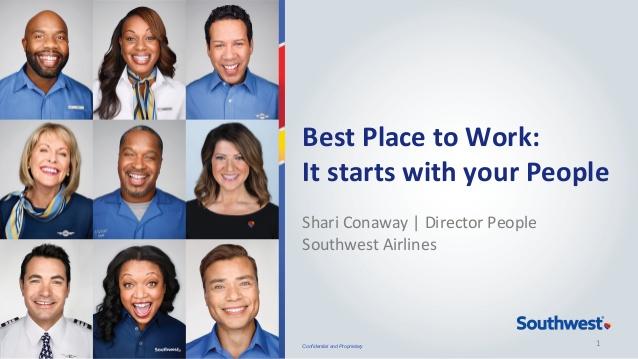
- Credibility builds on integrity and creates a powerful force in the marketplace. Because of its credibility, there is a perception that when Southwest comes to town, good things happen. “If you go to a mayor, a city council, or a congressman and say ‘Southwest Airlines is coming to your town,’ their reaction, generally, is ‘Hallelujah!” says government affairs VP Ron Ricks. “We have credibility because we tell people what we’re going to do and then we do it.
We tell people we’re about low fares and we offer low fares and give ordinary people an opportunity to do extraordinary things. There are airlines that match out low fares on a restricted basis, but there is no airline, low cost or high cost, that charges fares as low as Southwest across the board, consistently, all the time!”
- “Many organizations will fail in their quest for total quality service,” says Karl Albrecht, author of The Only Thing That Matters, “not because their leaders don’t understand the conceptual or technical requirements for achieving it, but because they don’t realize that the heart of the service journey is spiritual rather than mechanical. They will bureaucratize the whole thing and make it look like every other program.”
At Southwest Airlines, service transcends techniques. Southwest’s long-term customer satisfaction comes from service from the heart, from choosing service to self-interest. Service is not the result of teaching employees to act like customers are important; it comes from employees who genuinely feel loved and who work in an environment that dignifies them by valuing their contributions. When employees feel they are being treated humanely, when they receive legendary service,” they provide the kind of customer service for which Southwest Airlines is so well known. Perhaps this is why their willingness to serve is not an act but, rather, a true expression of the heart.
- In the first all-day Culture Committee meeting the authors attended at Southwest, the committee kept referring to the company’s “do the right thing” philosophy. When they got home, they continued to be puzzled by what they had seen. Many other employee groups they’ve interviewed and worked with over the years have expressed skepticism and apprehension when management offered this kind of discretion and empowerment. How did Southwest get its people to accept that freedom so enthusiastically
Since then, the authors learned. The company believes that employees comes first. And employees have come to embrace and live Kelleher’s characterization of what Southwest Airlines is: “We are not an airline with great customer service. We are a great customer service organization that happens to be in the airline business.”
When the systems, structure, policies, procedures, and practices of an organization are designed and lived out so that employees genuinely feel that they come first, trust is the result. Southwest employees trust the company and love its leadership. So they are not skeptical or apprehensive when management says, “Do the right thing.”
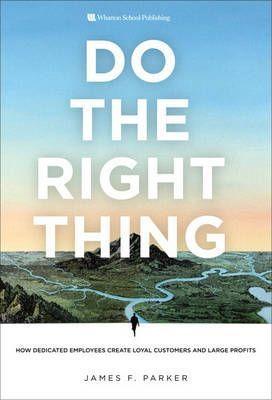
I trust that this compendium of mostly interesting things about Southwest Airlines has enriched your understanding of its original and innovative approach to management and entrepreneurship. To close, I quote this statement by Rosabeth Moss Kanter, author of World Class: Thriving Locally in the Global Economy, as it encapsulates the unique approaches that account for Southwest Airline’s outrageous success: “It shows the remarkable results when employees are liberated to take charge of the rules and have fun on the job.”
University of Experience is a special Aboitiz Eyes section that focuses on leadership insights from the unique experiences, perspectives, and wisdom of leaders who have stood at the helm of Aboitiz over the years.
If you enjoyed this article, would like to suggest a topic, or simply share your feedback, please CLICK HERE.


